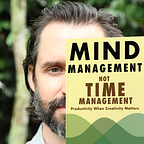Make it easy to do what’s good for you
Listen to an audio version of this article »
Every once in awhile, I shuffle around the icons on my iPhone’s home screen. I used to think about what apps I used most, but the other day, I realized that’s the completely wrong way to think about it.
If you’re like most people these days, you have some digital habits that you’d rather break. You find yourself uselessly scrolling on Facebook, you get into arguments on Twitter, or, even while reading this very article, you might be thinking about what you should be doing instead.
Our brains are dumb. They have a very finite amount of energy which can be used toward doing what we intend to do. But one shiny object on the edge of our field of vision, or a drop in blood sugar can derail us completely.
You can take advantage of this mental laziness. If you design your world to make it hard to do things that are bad for you, and easy to do things that are good for you, your behavior will shape to that design.
That’s why, this time, instead of thinking about what apps I used most, I thought about which apps would be good for me to use. Here’s what I came up with:
- Deep Relax: This is a guided relaxation app. More effective than a nap for me, and an alternative for when I don’t feel like meditating.
- Kindle, Audible, Podcasts: Reading books is good, listening to books is just as good, and podcasts I listen to are enriching.
- Pavlok: This controls a wristband that shocks me. I don’t use it much because it’s been very effective at curtailing my non-productive Facebook and Twitter use.
- Simplynoise, Pandora, Spotify: Sometimes I listen to brown noise to block out cafe conversations, otherwise, music helps me focus (I think Pandora has better stations than Spotify, thus I use both).
- Trello, Wunderlist: Someone I work with insists on using Trello. If I’m using it, it’s not to waste time. I prefer Wunderlist for repeatable things like packing for trips, or setting up to do interviews for my podcast. Again, I’m not going to find myself needlessly scrolling.
- Evernote: Good to access quickly for off-loading thoughts to the appropriate place for processing later, or taking notes for an article like this.
- FancyHands: If I can delegate something instead of doing it, that’s good.
The rest of my screen is filled up with things that are practical for me to use, but that have no chance of distracting me: Uber, Google Translate, & Google Calendar, for example.
I hid Facebook and Twitter in a little folder somewhere on a later screen. I don’t even know where they are. I have to search just to open either of them. This doesn’t totally prevent me from using them, but it prevents me from using them without consciously intending to, which cues me to set an intention for my session, rather than just using them mindlessly.
What would you put on your home screen? In what ways have you shaped your world to make it easy to do what’s good for you?
Did you get THIS FAR!? ♥’s are appreciated and get me writing more. –David
